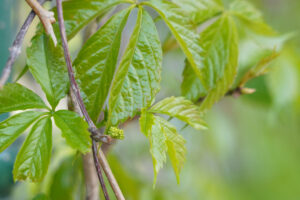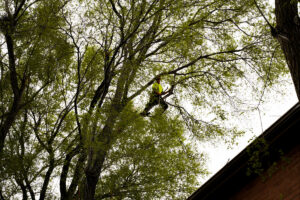During big summer storms, you might wonder if the trees on your property are at risk of falling. While Advanced Tree Care offers 24/7 Emergency tree services in case of damage after a storm, you want to avoid needing such a service if possible. There are many signs of tree health that can help indicate if a tree is at risk of falling during a thunderstorm. Read on for the signs of an at risk tree and how to inspect your trees so they don’t come crashing down during the next storm!
How to Spot a Sick Tree
Most healthy trees can withstand thunderstorms and other major weather events, but a sick tree is a different story. Take a look at the trees on your property. Have you noticed discolouration on leaves, trees that are losing their leaves at a time of year they shouldn’t, dead branches, or cracks or splits in the bark? If you’ve noticed any of these symptoms, you may have a sick tree. Healthy trees have even leaf coverage with strong colours, dense bark, and strong branches. Take time to inspect your trees to catch any issues before they become severe, and call the ATC experts for treatment options. Preventative care is the number one way to ensure your trees can stay strong during a summer storm!
Tree Fungus is Not Fun
Trees that are infected with fungus are at a higher risk of falling during a storm. Many signs of fungus mimic those of a sick tree, but there are a few additional symptoms to look out for. First, keep an eye out for soggy soil at the base of your tree which could be a sign of root rot. Look for mushrooms at the base of your tree, as this is also a sign of rotting roots which could lead to structural problems with your tree. If you notice mushrooms on the tree itself, that is a sign that there is rot under the bark layer, which will cause weakness in that area. Second, if you notice discoloration or wilting in your tree’s leaves, it is time to call the ATC experts for an assessment.
Lastly, cankers in particular are an indicator that your tree is suffering from a fungus. Cankers are sunken areas on the tree’s bark that are by-products of a fungus gaining access to the bark through a wound on the tree. Preventing wounds in your trees is the best way to reduce the risk of a tree becoming weakened due to a fungus.
Already Dealing with Tree Damage
If an unexpected storm has swept through your property and caused damage, the ATC team will evaluate the damage before beginning to clean up. If one of your trees has lost a branch due to a storm, a wound has been created. In particular, losing large branches can increase the likelihood of more structural problems that leave it at higher risk the next time another storm comes through. As we’ve discussed, the wound will need to be assessed to ensure no additional problems arise, such as fungus. Bad storms can cause damage to seemingly healthy trees, and sometimes that damage can’t be assessed visually. A tree that has been weakened already by a storm is at a higher risk of becoming even more of a problem during future storms. By keeping up with regular maintenance, your trees will be able to ride out the storm much more effectively.
Don’t Wait for the Storm
If you have surveyed your trees and believe they are showing symptoms of fungus, rot, or other diseases, call the ATC experts today. We will evaluate your trees for a hazard assessment and come up with a custom plan to keep your trees strong and healthy, so they can weather any storm! Whether you’re looking at tree pruning, reinforcing your trees, treatments for bugs, other pests, and more, Advanced Tree Care offers services customized to your trees!






